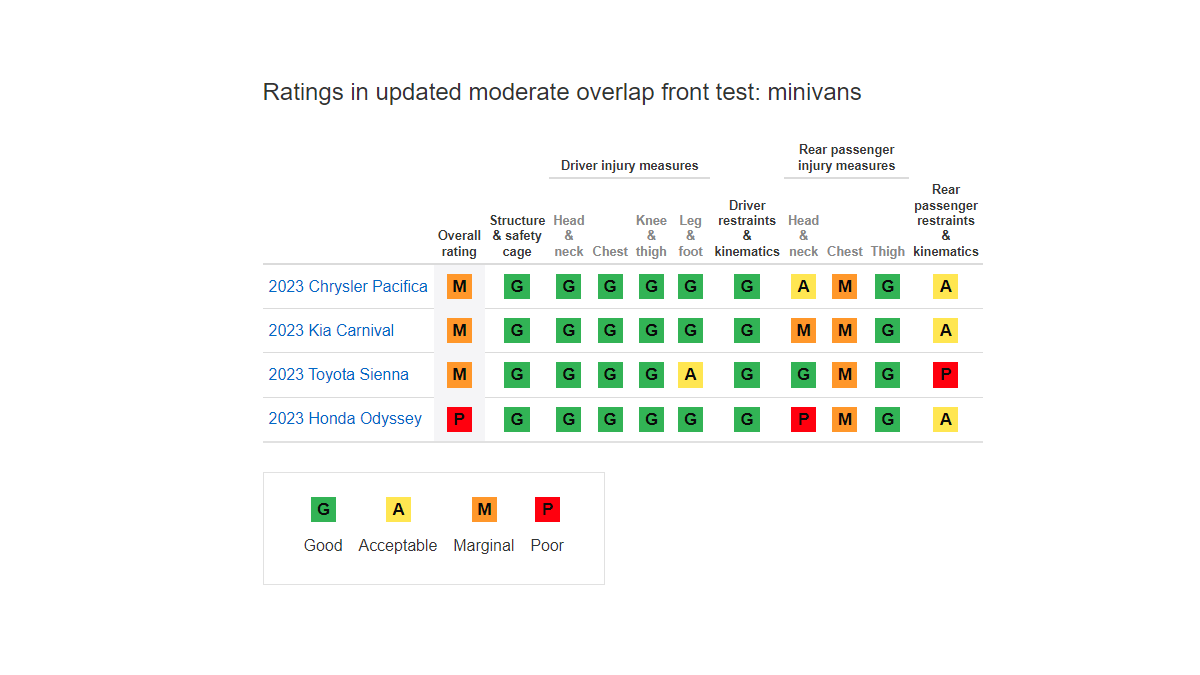In a new round of safety crash tests conducted by the Insurance Institute For Highway Safety, minivans came up short. Some of the top names in trusted family vehicles like the Honda Odyssey, Toyota Sienna, Kia Carnival, and the Chrysler Pacifica, failed to earn respectable results. “Back seat safety is important for all vehicles, but it’s especially vital for those, like minivans, that customers are choosing specifically to transport their families,” said IIHS President David Harkey. “It’s disappointing that automakers haven’t acted faster to apply the best available technology to the second row in this vehicle class.”
IIHS continues to challenge automakers by tightening its standards. This is an example of that. IIHS has recently changed its moderate overlap front crash test to look closely at what is happening in the second row of seats, as opposed to just the driver or just from passengers. IIHS’s testing discovered that the rear seat passengers were put at great risk.
In the testing, IIHS found that the rear dummy, which is the size of a small woman or 12-year-old child, would suffer harm in such a crash. “The restraint systems in all four vehicles leave the second-row occupant vulnerable to chest injuries, either because of excessive belt forces or poor belt positioning,” said Jessica Jermakian, IIHS vice president of vehicle research. “That’s concerning because those injuries can be life-threatening.”
The new test was designed to evaluate vehicles based on the likelihood of injuries based on the injuries first responders find in the real world. The researchers know that seat belts in the vehicles need to do many things, and most belts are great at keeping occupants in the seat. However, sometimes the seatbelts themselves cause harm. Tenson limiters help here. In other cases, the occupant “submarines” or goest below the belt as the crash occurs. Researchers designed the tests to watch for such problems.
In the Sienna, which scored the second-worst rating of Poor in the testing, the dummy submarined under the lap belt, and the shoulder belt slid off the shoulder toward the test dummy’s neck during the test. In the Carnival and Pacifica, the seat belt focused too much force on the dummy’s chest. Also, the Pacifica’s side curtain airbag did not deploy during the test as it should have.
The vehicle with the largest area for improvement was the Honda Odyssey. In the crash test researchers found the forces on the test dummy’s head and neck were higher still, and rear seat belt allowed the dummy’s head to come too close to the back of the front seat. The Odyssey received the lowest possible score of Poor by IIHS.
Click here to be taken directly to the IIHS test result page.
Despite the new testing results, IIHS scientists wish to clarify that the rear seats are still the safest places for children. IIHS says that the back seat remains the safest place for children, who are at risk of injury by an inflating front airbag. They also wish to emphasize that these new ratings do not apply to children secured properly in child safety seats.
Top of page Image of IIHS minivan crash test results courtesy of IIHS.
John Goreham is an experienced New England Motor Press Association member and expert vehicle tester. John completed an engineering program with a focus on electric vehicles, followed by two decades of work in high-tech, biopharma, and the automotive supply chain before becoming a news contributor. In addition to his eleven years of work at Torque News, John has published thousands of articles and reviews at American news outlets. He is known for offering unfiltered opinions on vehicle topics. You can follow John on Twitter, and connect with him at Linkedin.





